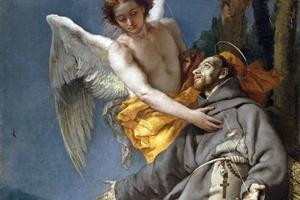This Famous Cookie Was St. Francis of Assisi’s Favorite Delicacy (and Last Meal)
The patron saint of Italy had a special weakness for mostaccioli, traditional dry biscuits that Italians still cook every Oct. 4 as a tribute to the famous stigmatist saint.
![Antoni Viladomat [1678-1755], “Saint Francis and Saint Clare at Supper in the Convent of Saint Damian” Antoni Viladomat [1678-1755], “Saint Francis and Saint Clare at Supper in the Convent of Saint Damian”](https://publisher-ncreg.s3.us-east-2.amazonaws.com/pb-ncregister/swp/hv9hms/media/20201004161044_3ac8a04453a1c1f085ad25b048077906e4a5687fae11b51976cf4c07418895ba.jpeg)
In the collective imagination, St. Francis of Assisi is considered the ascetic figure par excellence, to the point of being often seen as a kind of unearthly being who despised having a human body. However, a closer look to the hagiographies written by his contemporaries show that the reality was more subtle than this.
A telling example about this is St. Francis’ passion for mostaccioli — dry biscuits with almonds and honey (not to be confused with the pasta of the same name) that have been part of the Italian culinary tradition since medieval times. He tasted it for the first time during a trip to Rome while visiting the noblewoman Jacoba of Settesoli from the Frangipani family, who would become his close friend and who would later join the Secular Franciscan Order.
According to The Assisi Compilation — a 14th-century manuscript that gathers different anecdotes about the saint — the holy man who also was known as the “Poverello of Assisi” was so fond of it these delicious cookies that it was the last thing he was able to eat before dying, on Oct. 3, 1226. From his deathbed, indeed, while being already very weakened, he asked his companions to write a letter to Jacoba, begging her to come and visit him in Assisi for a last farewell, asking her to bring with her, in addition to gray garments for the funeral, those famous biscuits that she used to cook for him in Rome and that he loved so much.
This is how a long culinary tradition was born: Since then, it has been customary to honor the saint’s memory by cooking his favorite sweet every Oct. 4 — his feast day.
“Ultimately, these biscuits embodied this whole deep relationship of friendship and respect that St. Francis had with Jacoba of Settesoli, who affectionately cooked this sweet for him, and in this sense, food became a key of access to human hearts, an ideal instrument of testimony,” Giuseppe Cassio, historian of art and the author, in collaboration with Father Pietro Messa, of Il cibo di San Francesco. Anche di pane vive l’uomo (“St. Francis’ Food: Man Also Lives on Bread”), told the Register.
Fond of Food
In their book based on the writings and testimonies of other Franciscan friars who lived in close contact with him (such as Thomas of Celano and St. Bonaventure), Cassia and Father Messa debunk several myths surrounding the life and personality of the saint.
Indeed, the real figure of St. Francis is quite far from most ideological misrepresentations that are disseminated in contemporary societies. “Many people have found in him a kind of champion for various trends, making him a promoter of relativism, a kind of living skeleton, and above all a convinced vegetarian, which has little to do with reality,” said Cassio. “In fact, the sources of his time described a man who actually liked food, and who even had predilections for local traditional dishes that people cooked for him — and he did use to eat all kinds of meat, as well as freshwater shrimp, and a lot of honey and grapes.”
St. Francis’ approach was, according to the two authors, deeply faithful to the Gospel since food was for him a means to express his love toward his neighbors by sharing meals with them as often as he could, and by eating the food he was offered — just like Christ did in so many biblical accounts.
And it was also a way to express the true meaning of celebration, which he considered to be an important element of the Christian faith. “He absolutely didn’t expect his friars to fast in feasting times, and on Christmas day for instance, he wanted all men and animals to rejoice and be satiated with great and delicious meals.”
But these moments of communion around rich and abundant tables were in his view nothing but the culmination of a spiritual path that incorporated long periods of penance without eating anything.
“Fasting was very important to him indeed, but he was also aware that at a certain point, fasting must be aimed not to let oneself die, but simply to get in touch with God, depriving oneself of something as fundamental as food,” Giuseppe Cassio concluded. “In the face of the many invitations he was constantly receiving, St. Francis knew how to perfectly combine abstemiousness and pleasure of taste, by always giving importance to food at the right time.”
- Keywords:
- st. francis of assisi
- food

















